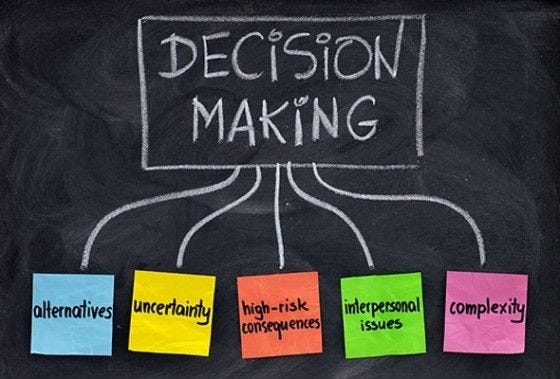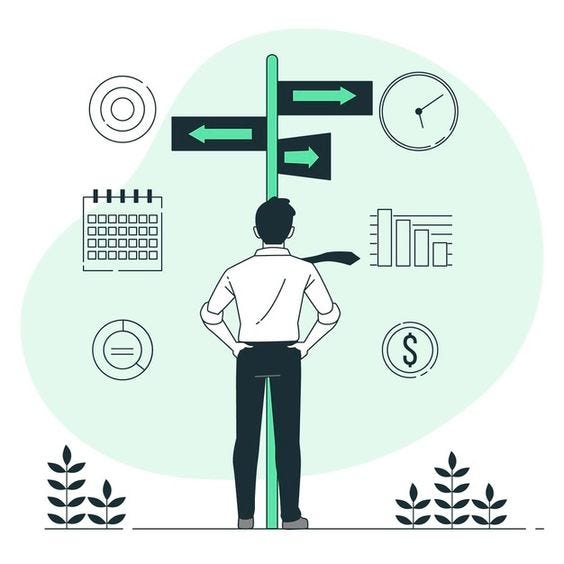Unlocking Decision-Making Potential with Mental Models
Written on
Understanding Mental Models for Better Decision-Making
In today's fast-paced environment, the concept of decision fatigue is all too real. From the moment we awaken to the time we retire for the night, we face countless choices. Studies suggest that an average individual makes around 35,000 decisions daily. This constant engagement can lead to mental exhaustion, highlighting the necessity of effectively managing our decision-making abilities.
As someone prone to overthinking, I experienced this mental fatigue firsthand. Every choice, regardless of its significance, was scrutinized to the point of exhaustion by midday. I needed a way to simplify my decision-making process without compromising the quality of my choices. Enter mental models—powerful tools that transformed my approach to decision-making.
Mental models are essential frameworks that make navigating complex decisions more straightforward. They provide structured methods for evaluating options and simplify the process by offering clear guidelines. By incorporating these models into my daily routine, I found clarity and tranquility, even when faced with tough decisions. Below, I will share five mental models that have greatly improved my decision-making.
The Decision Timing Rule
When uncertainty strikes before making a significant choice, I turn to the Decision Timing Rule. This model addresses the procrastination that often accompanies critical decisions. It is particularly beneficial when timing is of the essence, reminding us that taking prompt action can lead to significant outcomes and help us avoid the pitfalls of delay.
For example, when deciding whether to pause a project, consider the balance between the need for more information and the risk of missing opportunities and funding. Delaying even one day can narrow your options. Similarly, when you receive a job offer, timing is crucial; excessive hesitation could mean losing a transformative opportunity.
Understanding the Decision Timing Rule enables you to weigh the implications of postponing a decision against the need for further consideration. This model has empowered me to make timely and impactful choices, alleviating the mental burden of indecision.
“A peacefulness follows any decision, even the wrong one.” — Rita Mae Brown

The Pareto Principle
The Pareto Principle, often referred to as the 80/20 rule, posits that a small number of causes frequently lead to the majority of effects, which can significantly influence our outcomes. When applied to decision-making, this principle encourages us to concentrate on the most vital factors that yield the greatest results.
When faced with a complex decision, the Pareto Principle serves as a guiding light, helping us identify the key elements that will drive the majority of our desired results. It teaches us to focus on the few essential aspects, allowing us to allocate our time and resources more effectively and enhancing our decision-making capabilities.
For instance, if you are planning a marketing campaign for your business, rather than spreading your efforts thin across numerous channels, applying the Pareto Principle can help you identify the 20% of channels that will generate 80% of your results. By focusing your energy on these high-impact areas, you can maximize your marketing effectiveness.
Implementing the Pareto Principle not only sharpens our decision-making process but also empowers us to prioritize our efforts for maximum impact, protecting us from decision fatigue and facilitating strategic decisions that guide us toward our goals.
The Cost-Benefit Analysis
The Cost-Benefit Analysis is a strategic tool that aids in balancing potential costs against anticipated benefits for a decision. It provides a systematic framework for evaluating the pros and cons of various alternatives, assisting us in making informed choices.
When considering a decision, it is vital to examine both short-term and long-term implications. The Cost-Benefit Analysis encourages us to assess the potential gains and drawbacks of each option and quantify them. This method allows us to compare various scenarios and select the most rational choice.
For example, if you are contemplating investing in new software for your business, a Cost-Benefit Analysis would involve calculating the upfront costs associated with acquiring and implementing the software against the expected long-term benefits, such as increased efficiency and productivity. This evaluation of projected costs and benefits can inform your decision on whether the investment is worthwhile.
The Cost-Benefit Analysis guides us through the complexities of decision-making by offering a structured way to assess potential outcomes. By analyzing the trade-offs and balancing costs with benefits, we can arrive at more informed decisions and avoid the traps of decision fatigue.

The Pre-Mortem Analysis
The Pre-Mortem Analysis is a strategic method that involves imagining a scenario where a decision has already failed, allowing us to explore the reasons for that failure. By conducting a Pre-Mortem Analysis, we can identify potential challenges and pitfalls before they occur, enabling us to make stronger decisions.
Often, when making choices, we focus solely on the best-case scenario and overlook possible risks and failures. The Pre-Mortem Analysis shifts our attention, urging us to consider the worst-case situation. This mental simulation of failure helps us uncover potential weaknesses and blind spots in our decision-making process.
For instance, if you are planning to launch a new product line, a Pre-Mortem Analysis would involve envisioning the product's failure and identifying the reasons behind that outcome. This proactive approach can help you anticipate challenges such as market saturation or insufficient demand and develop strategic contingency plans.
Utilizing the Pre-Mortem Analysis empowers us to proactively recognize and mitigate risks, leading to more resilient decision-making. By anticipating potential pitfalls, we are better prepared to make informed choices that minimize the likelihood of failure.
The Opportunity Cost
Opportunity Cost is a fundamental mental model that highlights the value of alternatives we forgo when making a decision. It serves as a reminder that every choice comes with a cost, not just in monetary terms, but also in the use of time, energy, and other resources.
In the decision-making process, we often focus on potential gains. However, considering Opportunity Cost prompts us to evaluate what we sacrifice by choosing one option over another. This assessment of benefits and drawbacks for each choice leads us to more balanced decisions.
For example, if you are weighing the decision to accept a higher-paying job in a new city, the allure of a better salary can be compelling. However, it is essential to consider the Opportunity Cost, which includes the potential loss of your current job, the upheaval of relocation, and the impact on personal relationships. By weighing these factors, you can make a decision that aligns with your priorities and values.
Recognizing Opportunity Cost is crucial for understanding the trade-offs in our decision-making process. It enhances our awareness of the sacrifices we make, enabling us to choose options that align with our long-term goals and values, ultimately reducing decision fatigue.
Conclusion
In a world filled with choices, mental models are essential for simplifying the complexities of decision-making. They help us streamline our choices, lessen decision fatigue, and lead us to more informed conclusions.
The Decision Timing Rule emphasizes the importance of prompt decision-making, while the Pareto Principle encourages us to focus on the few critical elements that will yield the most significant results. The Cost-Benefit Analysis aids in weighing potential costs against benefits, the Pre-Mortem Analysis helps us foresee and mitigate risks, and Opportunity Cost prompts reflection on what we relinquish when we make a choice.
By harnessing the power of mental models, we can master the art of decision-making and shield ourselves from decision fatigue. When faced with a multitude of choices, remember the strength of mental models to make confident decisions and attain clarity.
“A peacefulness follows any decision, even the wrong one.” — Rita Mae Brown
The first video, "Shane Parrish: The Great Mental Models," delves into essential mental frameworks that enhance decision-making and provide clarity amid confusion.
The second video, "Mental Models Explained: 6 Mental Models from Charlie Munger," offers insights into various mental models that can aid in making better decisions.